Many of the nurserymen at a meeting in 1913 were very enthusiastic about native plants: They are beautiful. They don't need summer water when they are established. They harmonize with the natural landscape. We should be selling them.
At the 1913 Third Annual meeting of the California Association of Nurserymen (CAN), Theodore Payne, a noted horticulturalist and native plantsman from Southern California, presented some of his recommended California native plants for California gardens. The comments after his speech were very positive about the market for native plants. Here are a few of the remarks:
"...California probably has more beautiful native plants than any other state in the Union. Now it seems to me that we need a nurseryman in California to propagate some of these native plants." Geo. C. Roeding, Fancher Creek Nurseries, Fresno, California
"Every State and community should develop its own native trees and shrubs, but what is a man going to do when he grows a fine assortment of native stuff and finds it dead stock on his hands? ... Our native shrubs and trees are more extensively planted in Europe than they are in the United States." J.B. Pilkington, nurseryman, Portland, Oregon
"Like Mr. Roeding, I think it is time that some one of us should take up this enterprise of growing native plants and trees in California. In my work in Southern California, I have utilized a great many native shrubs, like the wild lilac and cherry. There is nothing nicer to plant than the wild honeysuckle and clematis. They make as good a show as any other plants." J.B. Morely, superintendent, San Diego Parks
"I quite agree with Mr. Morley and Mr. Roeding. Heretofore we have never had a call for native California plants. I was asked advice by a man who expects to layout a big place this coming spring, and he is the first man who has asked me for anything in that line. He said, "Mr. Cann, I do not want big vases, nor statuary; neither do I want my house to be seen. I would like for you to work with the architect, and make my place as near nature as possible." Arthur Cann, seedsman and nurseryman, San Jose, California
"...I consider the way to handle such sites is to plant native trees and shrubs, and put them in as nature intended making it, and the whole place will be taken care of without any artificial water, and I believe that any nurseryman who has native stock will have a great sale for it from now on." Theodore Payne,
nurseryman and seedsman, Los Angeles, California
The following is Mr. Payne's presentation from the 1913 CAN meeting in Fresno (see References below). I've added links and pictures to illustrate his talk. The links are to Calflora, wikipedia, my favorite witty native plant retailer website (Laspilitas.com) (lp), and flickr photos. In some cases, the names of the plants have changed and I have noted their currently accepted names.
The native plant fans will notice that this list of plants is very familiar and many of these plants are in in the native plants nursery trade today.
The proceedings included the discussion after Mr. Payne's talk. The members' remarks are quite interesting, so don't miss them!
The native plant fans will notice that this list of plants is very familiar and many of these plants are in in the native plants nursery trade today.
The proceedings included the discussion after Mr. Payne's talk. The members' remarks are quite interesting, so don't miss them!
NATIVE VEGETATION
Mr. President, Ladies and Gentlemen:
The demand for California native plants is rapidly increasing in all parts of the state. In my report at your last annual convention I devoted considerable time to a discussion of the peculiar adaptability of the native plants for our gardens, parks and public grounds; the advantage of growing plants requiring no artificial watering and the advisability of establishing native dry land parks where every plant should be native to the state and depending entirely upon the natural rainfall - the fact that these plants harmonize with our landscapes and are more suited to our conditions than any exotic plants brought here from other parts of the globe. I will not take more of your time with this phase of the subject but will continue with a discussion of some of the most desirable shrubs other than those mentioned in my last year's report.
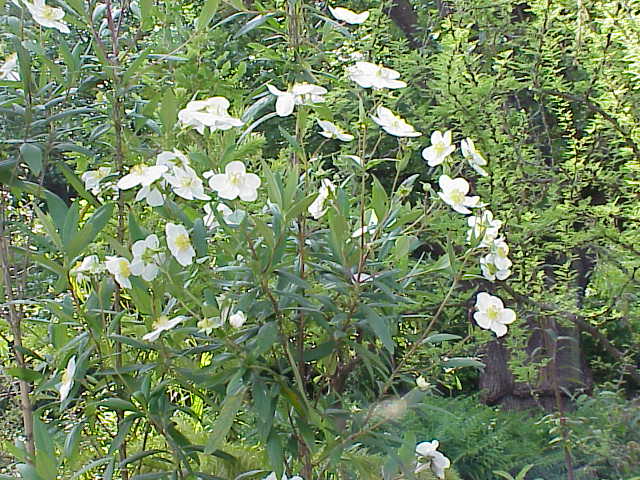 |
| from wikipedia |
.jpg) |
| from wikipedia |
 |
| from wikipedia |
 |
| from wikipedia |
 |
| from wikipedia |
 |
| from wikipedia |
On many dry ridges in early summer may be found the Woolly Blue-curls or "Romero," as it is called by the Spanish (Trichostema lanatum) (lp, flickr). It is of shrubby form with small crowded leaves resembling the foliage of the common Rosemary. The buds and flower stems are covered with a thick purple
wool, the flowers themselves being of a deep rich shade of blue. This plant is always found in dry places and will not stand a wet situation.
 |
| from wikipedia |
The Manzanita is well known to everyone and is one of the most beautiful of our wild shrubs. It flowers in the early part of winter and clusters of fragrant, waxen bells contrast well with the pale foliage and rich brown stems. There are many species, Arctostaphylos tomentosa (lp, flickr) - being the commonest form in Southern California. A. manzanita, A. glauca and A. patula are some of the most desirable. The Manzanita is hard to propagate, the seed being uncertain and very slow in germinating. One nurseryman I know of has been quite successful in layering plants out in the hills and afterwards digging up the rooted layers. Anyone who is successful in raising stock of this shrub can be assured of a high price for his plants.
 |
| from wikipedia |
In many canyons bordering on the Colorado desert may be found the Dalea spinosa (now Psorothamnus spinosus, lp, flickr), often called the "Smoke Tree." On account of its ashey gray color it is often mistaken at a distance by those who are unacquainted with it for a column of smoke. It is very variable, frequently forming a small shrub four to five feet high, while in other cases it will attain a height of twentyfive feet with a trunk diameter of ten inches. The flowers, which appear about May, are pea-shaped and produced in great profusion. The color is the richest shade of dark blue I have ever seen in any flower.
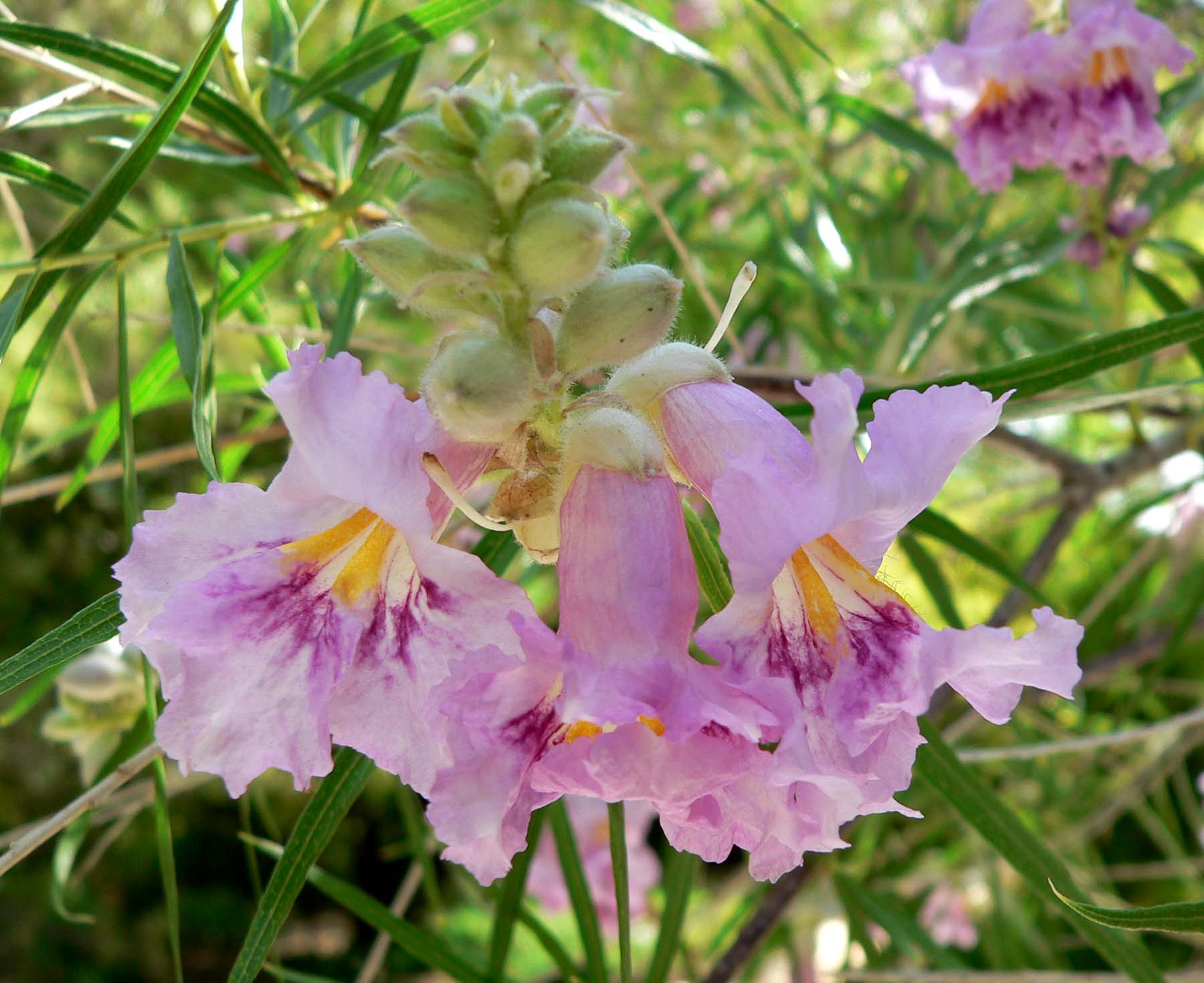 |
| from wikipedia |
Another shrub found in the same locality is the Desert Willow (Chilopsis saligna) (now Chilopsis linearis, lp, flickr), a slender growing deciduous shrub or small tree with narrow willow-like foliage. It belongs to the Bignonia family and the flowers are white and purple blotched with yellow in the throat.
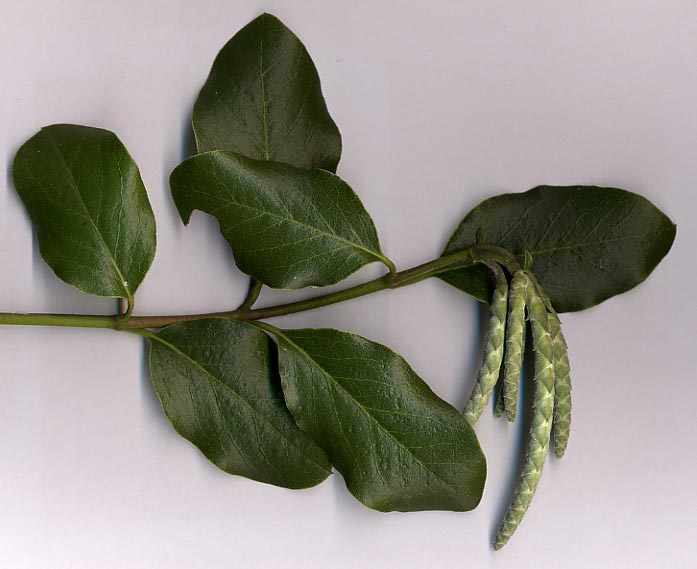 |
| from wikipedia |
Garrya elliptica (lp, flickr), the "Silk Tassel Tree," has been in cultivation for a considerable time. Another species worthy of notice is Garrya veatchii palmeri, which is frequent in the upper portions of the Chaparral belt of the San Antonio and Cuyamaca mountains.
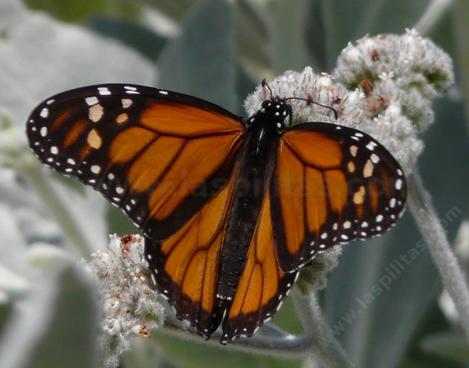 |
| from Laspilitas.com |
Two very interesting shrubby flowering plants found in dry sandy soil are Eriodictyon tomentosum (lp, flickr), which has gray, woolly stems and leaves, with violet blue flowers resembling the Heliotrope. Eriodictyon parryi has handsome foliage and numerous long spikes of rich blue flowers.
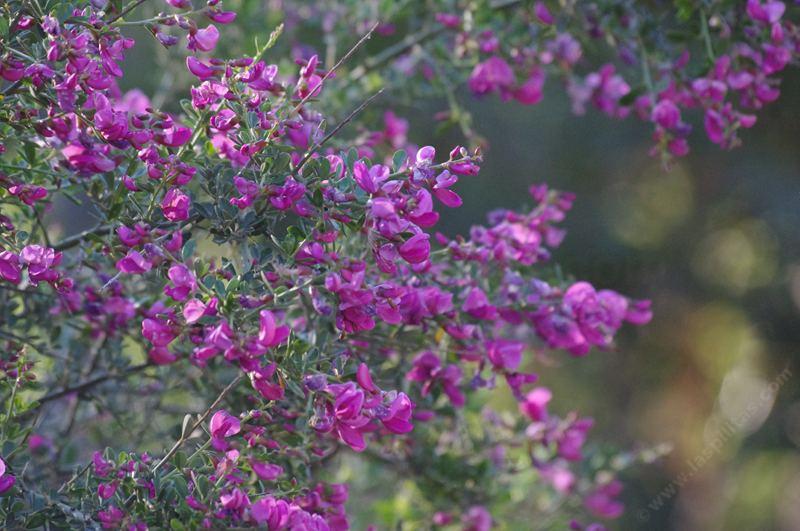 |
| from Laspilitas.com |
On mountain slopes in our Coast range may be found the Chaparral pea (Pickeringia montana) (lp, flickr), where it often forms dense impenetrable thickets. The leaves are small, dark green, and the branchlets terminate in long ridged spines. The flowers are large pea-shaped and of a magenta pink shade.
 |
| from wikipedia |
 |
| from wikipedia |
edge of the desert; it has whitish foliage almost the color of the White Sage, forms a compact bush and produces a perfect wealth of bright yellow flowers on long stems.
A very rare shrub found only in one locality is Berberis nevini (now Mahonia berberi, lp, flickr). It forms an extremely handsome and compact bush with prickly foliage and long sprays of small yellow flowers, which appear about February. Berberis dictyota is a low growing plant often found in shady places and is valuable for its rich foliage, which is very similar to that of the Oregon Grape.
The Mountain Mahogany (Cercocarpus betulaefolius) (now Cercocarpus betuloides, lp, flickr) is a pretty shrub of rather spreading habit with small dark green leaves. The flowers are quite small and inconspicuous, but the long feathery plumes of its fruit are quite pretty. It is particularly valuable for planting in dry places.
 |
| from wikipedia |
 |
| from wikipedia |
 |
| From wikipedia |
Another desirable species is Malvastrum davidsoni, which has larger flowers of a rose-purple shade.
 |
| from wikipedia |
The Wild Honeysuckle (Lonicera subspicata) is a climbing shrub particularly valuable on account of its great wealth of shiny green foliage. Holodiscus discolor (Native Spiraea), Symphoricarpus mollis (Snowberry), Lotus glabra (Broom) (now Lotus tenuis), Lepidospartum squamatum and many others are worthy of cultivation.
In conclusion, I would recommend nurserymen, who are raising ornamental stock, to pay special attention to California native plants.
THEODORE PAYNE, Chairman,
JOHN GILL,
CHARLES WINSEL.Mr. Payne: I would like to add a word or two. There may be some that I have omitted in this list, because I mentioned them in my last year's report, making a total of about fifty native shrubs, all of which can be grown without artificial water. I have not named any of those that grow on streams or near water. Of course, I do not mean to say that these plants will grow when planted without care. Some people have the idea that because they are native trees, all they have to do is simply to plant them and they will grow without any further attention, but you must water them the first summer, and after that you can make them grow without any artificial water.
The Chair: This is a complete and good report. Are there any remarks from anyone on it?
Mr. Vallance: I would like to ask Mr. Payne if he would call the Mexican Flame Flower a native shrub?
Mr. Payne: Is it Mexican or California? If it is a Mexican species I do not know much about it.
The Chair: I have been much interested in this paper. It seems to me, although I could not hear very well, that there is a chance to do some missionary plant work.
Mr. Payne: In last year's report, I simply took up shrubs, and in this report I continued that subject, and this committee suggests that I take up native trees, and there are many native species that are called trees or shrubs. Sometimes a shrub will be two or three feet high, and sometimes it will be twenty-five feet high, but in this list I endeavored to give only those that are known as general shrubs. The Elder, the Cherry, etc., that are known as shrubs or trees, I will treat of as trees.
Dr. Cook: You have not mentioned the Salvia carduacea (Thistle Salvia), which is a beautiful flowering plant. Its method of growth is singular. It forms a blossom about the size of a croquet ball, with many stems coming right out of the ball, and on these are formed still another set of blossoms. It makes beautiful house plant, and it will last for days when placed in a vase. I only want to know why it has not been cultivated and listed in the catalogues.
Mr. Roeding: I dislike very much to have a paper like Mr. Payne's passed over without having a few remarks concerning it. The nurserymen of this state have set themselves up as educators, in a way, for the public at large in reference to horticulture and agriculture. Mr. Payne's paper gives an idea that should not be lost sight of, and that idea is this: That California probably has more beautiful native plants than any other state in the Union. Now it seems to me that we need a nurseryman in California to propagate some oil these native plants, and I hope as a result of the education that Mr. Payne is trying to give the nurserymen that there will be one California nurseryman who will take up this branch of horticulture. As Mr. Payne said in his paper, "Many of the California plants are very difficult to propagate." I know that to my sorrow. I think this is a field that ought to be taken up by a careful investigator, one who has a desire to promote the horticultural work of California, not only for the pleasure that he will derive for himself, and the profit that he will receive from it, but to encourage home lovers to plant more of the California plants. The fact of the matter is that you see comparatively few of the California plants in any of our gardens, and this is a thing that should be taken up and developed. I know some of the California plants, but I am sorry to say that I am not familiar with many of them. There are plants mentioned by Mr. Payne that I am not not familiar with, and I believe few in the audience are. I think that some nurseryman ought to propagate these plants and distribute them. I believe there is one man who has taken up this work, but he is not a California nurseryman, but we need a California nurseryman to take up this particular branch, and doubtless it will prove profitable.
 |
Delegates at the Third Annual Convention of the California Association of Nurserymen, October 1913 Notice that Geo. C. Roeding is front and center in this picture in front of the Carnegie Library in Fresno. Where are Theodore Payne, Donald McLaren, Leonard Coates, Professor Wickson? (The 1911 CAN group photo here has named each particpant which could help identify others.) |
The Chair: I would like to hear a suggestion from someone in the audience on this.
Prof. Wickson: I cannot go into the science of the thing, but there is a practical phase of the situation that appeals to me very strongly, and that is that we have so many landscape gardeners in California, and it is quite new to have so many people calling for expert assistance in laying out their places. The men who are doing work in that line are finding patrons, and doing good work which would not have been possible to undertake many years ago because of the lack of demand. It is not very long since the Califomia planter had a notion that he could layout his own place, and he was not disposed to call for expert assistance. Now these people want plants for certain purposes, they want to produce color effects, and they are short of information, and they are especially short of information on the native plants. They would like to use them in ways that are most effective. They go to the botanist and inquire of him, and he often makes suggestions that are valuable, and then they take it up from a horticultural point of view. I agree with Mr. Roeding, that someone ought to give his time to that line of propagation, and get out a publication and distribute it among the landscape gardeners who use a large quantity of these, and to those propagating plants in this line. It would be a public service. It seems to me that the point Mr. Roeding brought out is one of the most important things which has been made with reference to horticultural work in ornamentals in California.
Mr. Pilkington: Mr. Roeding is on the right track. These conditions also exist in Oregon, and have existed in every State, but, looking at it from a nurseryman's standpoint, we can grow the stuff, but the problem is to sell it. Every State and community should develop its own native trees and shrubs, but what is a man going to do when he grows a fine assortment of native stuff and finds it dead stock on his hands? That is the discouraging feature to the grower, hence it is a matter that should be taken up by a specialist, and he will have to go into it very carefully. Our native shrubs and trees are more extensively planted in Europe than they are in the United States.
Mr. Morley: Like Mr. Roeding, I think it is time that some one of us should take up this enterprise of growing native plants and trees in California. In my work in Southern California, I have utilized a great many native shrubs, like the wild lilac and cherry. There is nothing nicer to plant than the wild honeysuckle and clematis. They make as good a show as any other plants. Now in San Diego we have about 10,000 shrubs on hand, all raised from seeds during the last year. We are making an endeavor to cover the hills with native plants. People seem to have an idea that they should keep the native shrubs growing there for future generations.
Mr. Cann: I quite agree with Mr. Morley and Mr. Roeding. Heretofore we have never had a call for native California plants. I was asked advice by a man who expects to layout a big place this coming spring, and he is the first man who has asked me for anything in that line. He said, "Mr. Cann, I do not want big vases, nor statuary; neither do I want my house to be seen. I would like for you to work with the architect, and make my place as near nature as possible." It means a large contract. I believe that from now on there will be more calls for plants of California than there has ever been before. I have only recently been all through the parks of the largest cities of Europe, and they have utilized many California plants advantageously. We have never had a call for much of this kind of stuff, but believe you can sell it. The chances are that if Mr. Payne has a stock this coming spring I could use some of it myself, but it would not pay me to grow it. I believe in every fellow staying in his own line, as it usually takes years to learn the first principles of the game.
Mr. Payne: In the past I do not think anyone who has raised native stuff ever found a demand for it, but there is a growing demand for it now. In the past many laid out their homes in the cities and in the valleys where there was plenty of water. The hillsides were practically vacant fifteen years ago; now they are the places that rich people want for their homes, and when they get a large place the greatest problem is water. Some people have made an effort to develop these places on the old lines-that is, laying out terraces and lawns, etc.-but after this is all done it does not harmonize with the natural landscape, and is extremely expensive, so that after all they have come back to the idea of keeping the landscape as nature intended it, and plant native plants with the idea of preserving the natural beauty. Many landscape gardeners coming in from the east are taking up that idea, and when they undertake to arrange, or beautify a place, or grounds that contain native trees or shrubs, or to give advice on same, one hears them say, "I would not touch that tree or that shrub, for anything; I would keep that just as it is." Now I consider the way to handle such sites is to plant native trees and shrubs, and put them in as nature intended making it, and the whole place will be taken care of without any artificial water, and I believe that any nurseryman who has native stock will have a great sale for it from now on.
Mr. Cann: I agree with Mr. Payne in some of his remarks, but it would not do for everybody to plant native plants. It would not look good. You must have some grass. or I would like to know where the seed men would get off at. You must have some green. We have got too much of that dryness already. it would not do for everybody to plant native plants. It would not look good. You must have some grass. or I would like to know where the seed men would get off at. You must have some green. We have got too much of that dryness already.
Mr. McDonald: I was just going to say that I think that every nurseryman in California should take a trip to the Sacramento Valley at the present time. It certainly would be an inspiration in this line. The color effects produced by the native trees On the sides of the valley are simply beautiful. Now as for the sale of the native trees and plants, I think it is largely the fault of the nurseryman. If we get some specialty from Europe or Asia we give it a page in our catalogues, but we never think of describing the beautiful plants at home. I think that the nurserymen as a whole should take up this question of advertising the native plants. We have not placed these plants before the public, hence they have not asked for them. If you will have some specialist in California who will take up this work of propagating species of your native trees and shrubs I believe it will prove a success. I am heartily in sympathy with this subject, and hope that someone in Californiawill take this up; but we do not want you to come to Oregon, and appropriate any of the trees and shrubs from our State.
Mr. Vallance: These remarks are all very beautiful, but those who have tried to propagate the native trees and shrubs know it to be a difficult matter, and the one who gives his time to that business. I would not call a nurseryman but a philanthropist. I think it is a matter that should be taken up by the State. I would like to see the man who could do it. Why could not the State University take it up for the benefit of the whole State?
Mr. Grant: The last speaker would like to see the man who could raise these things. I have 10,000 raised from last year's seeds. The simplest thing in the world to grow is the native shrub. To my mind the whole thing is simply a question of supply and demand, and we have got to put it before the people and create a demand. We know that each year the people are going from the valleys to the hills. "The graves of today will be the gold fields of the future." Is it not also true that the hillsides of today will be the homes of the future?
References:
- Transactions and Proceedings of the Third Annual Meeting of the California Association of Nurserymen, Held in Fresno, on Thurs. Fri. and Sat. October 16-18, 1913. Theodore Payne's paper is on pp. 30-37.
- Transactions and Proceedings, The California Association of Nurserymen 1912, 1913, and 1914 are available on Hathitrust.
- Theodore Payne also talked about native plants at the Ninth Annual Meeting of the Pacific Coast Nurserymen, June 21, 1911. George C. Roeding was president that year. The nurserymen visited the California Nursery on June 23, recorded on p. 109 with W.V. Eberly as host of the outing.
- THE SIGNIFICANCE OF NILES CANYON IN THE PHYTOGEOGRAPHY OF THE COAST RANGES OF CENTRAL CALIFORNIA Cherie Lalaine Rivers Wetzel


No comments:
Post a Comment